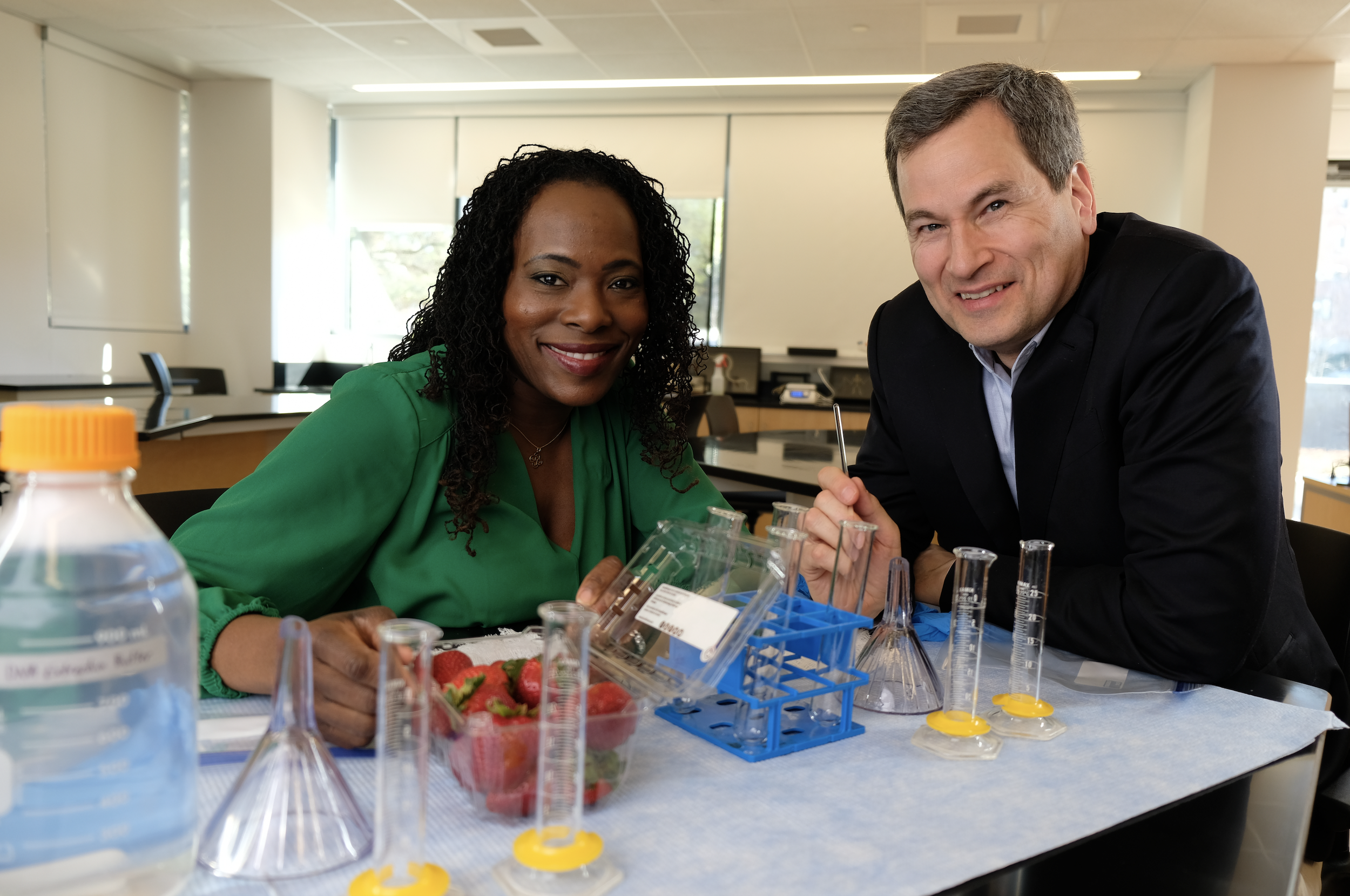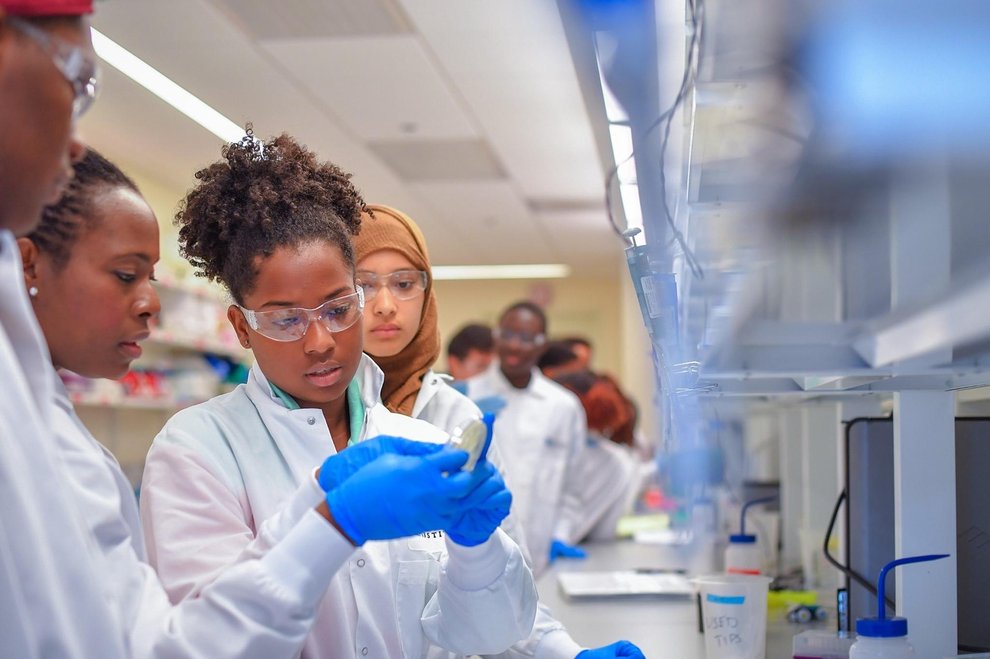Reflecting on the Power of Experiential Learning with Biologist Dr. Monica Hall-Porter
The pandemic has significantly changed approaches to experiential learning with the shift to virtual classrooms. Monica Hall-Porter has found creative ways to model new methods for this type of pedagogy.

Monica Hall-Porter and David Pogue extract DNA from strawberries in the new NOVA series Beyond the Elements. Image courtesy of GBH
“As we think about the best ways to educate students in STEM disciplines, we have to keep in mind that a lot of students have experiences with STEM where they may be discouraged,” says Monica Hall-Porter. “But if we can expose students to hands-on learning throughout their educational process, and give them the ability to explore, to ask questions, to experiment, it really does enhance the outcome!”
Monica Hall-Porter has dedicated her career to creating a robust pipeline for students who are interested in pursuing STEM (science, technology, engineering, and mathematics) careers. As the faculty development coordinator in the College of Natural Sciences at the University of Texas in Austin, Hall-Porter supports professional development for faculty that centers on improving and enhancing science pedagogy.
Throughout her career, Hall-Porter has advocated for best practices in STEM education, specifically methods to promote and sustain student engagement. By creating opportunities for students to have hands-on experiences in laboratory settings, they can see science processes in action.
Take the Freshman Research Initiative (FRI) at the University of Texas. Through this program, first-year students experience the excitement of scientific discovery firsthand. Participants do real-world research, use cutting-edge lab equipment, develop technological innovations, and publish papers in peer-reviewed science journals.
In addition to her contributions to the University of Texas, Hall-Porter has mentored students through the Minority Introduction to Engineering and Science (MITES) program at Massachusetts Institute of Technology (MIT), and Science Club for Girls in Cambridge, Massachusetts. In these settings, students have the agency to ask thoughtful questions as they conduct their experiments, and are expected to record and interpret the data, mirroring the work that scientists do.
Though the pandemic has significantly changed approaches to experiential learning with the shift to virtual classrooms, Hall-Porter has found creative ways to model new methods for this type of pedagogy. She recently led a virtual field trip with NOVA Education where she built DNA models with candy and ran a strawberry DNA extraction lab! Using common household items, she showed just how easy it can be to create experiential learning experiences at home. She is also a featured scientist in the new three-part NOVA chemistry series Beyond the Elements: Life. This event is the first in a series of three virtual field trips highlighting some of the scientists and engineers featured in Beyond the Elements.
NOVA spoke with Hall-Porter about the impact of experiential learning on her own educational journey—and on students in general—and advice for educators on how to incorporate experiential learning into virtual classrooms during the pandemic.
Kara Norton (KN): What path did you follow into the laboratory research field? What attracted you to this career?
Monica Hall-Porter (MHP): I'm originally from Hawkins, Texas, which is a small town of about 1,330 people in Northeast Texas. I left Hawkins in the fall of 1996 to attend Hampton University in Hampton, Virginia. I was a biology major and I was part of a unique scholarship called the Minority Access to Research Careers (MARC) Scholars program. One key feature of the scholarship is that every summer MARC scholars were required to do research or engage in research projects in various institutions across the country. So, I interned at NASA through Florida A&M University. I also worked at the University of Washington in a couple of different labs throughout my undergraduate career. I really developed an appreciation for research in a couple of different fields, but mostly research models centered around molecular and cellular biology. After Hampton, I went on to graduate school at Wake Forest University in Winston-Salem, North Carolina. I was a student in a molecular- and cellular-biology-based graduate program that was run out of the pathology department of Wake Forest. During my time as a grad student I received a lot of exposure to a research unit that did work in establishing the molecular link between estrogen and cardiovascular disease, specifically as it relates to the loss of circulating estradiol after menopause. I will say that I received, through my undergraduate education and my graduate education, some of the best education that the country has to offer.
KN: How did those early experiential learning opportunities during your undergraduate and graduate career inform the work that you currently do?
MHP: As we think about the best ways to educate students in STEM disciplines, we have to keep in mind that a lot of students have experiences with STEM where they may be discouraged, or they may not be as curious because of the way that the curriculum is presented. But if we can expose students to hands-on learning throughout their educational process, and give them the ability to explore, to ask questions, to experiment, it really does enhance the outcome!
I would say the same is true of my experience. I remember when I interviewed at Wake Forest for the position in the graduate program, one of the remarks that the professors made was that I had the ability to talk about the research I had participated in leading up to that moment. Specifically, to convey how the work that was being done in the laboratories that I worked in was advancing each respective academic field. I think providing chances to do hands-on work coupled with the ability for students to communicate the science is really the key to creating a robust pipeline of students who are interested in pursuing STEM careers.
KN: I would love to hear more about the work you are doing with Texas Institute for Discovery Education in Science (TIDES).
MHP: TIDES is a dedicated teaching and learning unit that is housed in the College of Natural Sciences (CNS) at the University of Texas at Austin. It is unique in that it provides support in several different ways to teaching and learning in CNS. There is a very exciting program here called the Freshman Research Initiative (FRI). The FRI is the crown gem of experiential learning here. Through this program, students who are freshmen get the opportunity to work on research projects in established research labs at the University of Texas. There is a significant educational structure surrounding students who work in the FRI, and it really does give them a chance to dive into the pursuit of various goals in dedicated research labs.
TIDES also has a faculty-facing unit called TIDES Instruct. This is the unit that I'm a part of. We work to support professional development for faculty that centers on science pedagogy. We support all the departments of the CNS in various ways. Course Design Institute, curriculum redesign efforts to ensure that the curricula are student centered and take the best of what is known about teaching in STEM and present it in a way that faculty can readily implement strategies in their course to improve and enhance their teaching.

Monica Hall-Porter (second from the left) assisting students in the MIT MITES (Minority Introduction to Engineering & Science) genomics course in 2019. Image courtesy of the MIT Office of Engineering Outreach Programs (OEOP)
KN: Throughout your career how have students responded to experiential learning? Could you describe some of the impacts?
MHP: When I was a graduate student and a postdoc, I had multiple opportunities to support undergraduate students who were completing summer research experiences and internship experiences in the labs where I worked. What I will say is that just like in a traditional classroom, we have what I call ‘light bulb moments' where students really start to connect the dots regarding biological processes or phenomena that they're learning about. Not only are students learning about a process, but then they also have the ability to get hands-on experience with the process, and it really does help to solidify learning in a lot of ways.
With the Minority Introduction to Engineering and Science (MITES) program at Massachusetts Institute of Technology (MIT), I just saw students come alive in the lab! One example was with a genomics course I was teaching in conjunction with the MITES program. In this course, students do a skin microbiome project where they swab their skin and put it on what we call a bacteriological media plate. They grow the microbes that are on their skin. Through a set of steps, they use bioinformatics and DNA sequencing to identify the microbes present. Students learn about the importance of the skin microbiome and how the organisms that grow on us actually support our body systems, not only on the skin, but also in the gut, and the lungs even, which are also hot areas of research as it relates to the human microbiome. After taking part in hands-on experiences like this one, students are just hooked on STEM! Again, the experiences that are provided don't have to be grand in scope. They can be entire unit exercises or they can be small experiences, but anything we can do to get students in a hands-on experience, again, enriches their future in STEM careers.

Monica Hall-Porter examining a synthetic cadaver as part of an anatomy and physiology laboratory class she taught at Lasell University. Image courtesy of Monica Hall-Porter
KN: Is this something that could be adapted to high school students and not just university students?
MHP: Absolutely! I believe there's always a way to infuse hands-on learning into the experience. I'd love to see more of that across the country. Look at the virtual field trip that we are doing, experiences like this make science accessible. I've done science outreach with students who are as young as five years old. There is joy in that experience, not only for the student, but also for the educator.
There's an organization based in Cambridge, Massachusetts, that is near and dear to my heart. It's called the Science Club for Girls. When I was a postdoc at Tufts University, one of my very good friends invited me to the club. I went with her and ended up being a volunteer and mentor scientist. During one of those sessions with the young ladies, we actually dissected cow hearts. Now fast forward several years, that was a foundational experience for one of those girls who was there because now she's a senior neuroscience major getting ready to graduate from Harvard University and I believe go on to medical school. She cherishes that experience as this moment where she realized that not only is a STEM career possible, but she also knows people who are doing this work and they support her.
"She was really able to develop not only an appreciation for science, but a sense of belonging in STEM, which is very important as it relates to fostering students to go on to pursue careers in science."

Monica Hall-Porter (left) instructs middle school participants to hold hands to demonstrate the different types of chemical bonds during an event with the Urban League of Eastern Massachusetts. Image courtesy of Monica Hall-Porter
KN: Would you say that being able to provide these experiences is one of the most rewarding aspects of your work?
MHP: The work really did follow me straight from my office in a university setting to the community where I facilitated hands-on science experiences for young folks. It definitely is one of the more rewarding aspects of my career because I do get to see students really come alive with regard to their love of STEM. But conversely, the other side of that is the ability to help faculty to facilitate their experiences in their own classroom that promote the best practices in STEM education. It's also very rewarding because it tells me that I have the ability to communicate scientifically important messages to a lot of different audiences. I believe that that's a very important skill to have, one that moves the work of promoting best practices in science education. I can't help but be proud of that. So those are the two things that I'm most proud of with regard to how my career has progressed.
KN: Thinking about how the pandemic has affected experiential learning opportunities, I'd love to hear your thoughts on how educators might adapt.
MHP: As we engage virtually, I would encourage educators to still pursue experiential learning, but do it on a micro scale. Keep it simple. Take advantage of resources that you already have that are readily available. For example, on our virtual field trip we are going to extract DNA with household materials. Not anything grand and ornate, but enough to keep interest stimulated; it's really important, and it’s something that can be done easily. Additionally, at all levels, whether it's during an unprecedented pandemic or a time that we would consider more normal, take advantage of opportunities that come your way. If you are in the position to ask for an enrichment activity or something that you want to do, don't hesitate to ask. My son's teacher has this activity that she uses called “fast finishers.” If students finish their work before everyone else, then they have this packet that they can go to that provides enrichment, or an activity for them to try to work on while they're waiting for the class to progress.
Whether educators are resource endowed or not, throughout this pandemic I have been absolutely floored and inspired by the work that educators at the K-12 level, and also higher ed, are doing to facilitate learning in the pandemic. I don't think we can say enough about what our teachers and professors are doing at this time. For a lot of students, it is providing a perpetual beacon of hope, one that they can achieve, and will achieve. And I don't think we can appreciate that enough!
This interview has been edited for length and clarity.

For more at-home science ideas, watch Monica Hall-Porter’s virtual field trip!




